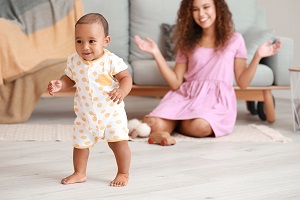10 Tips to Help Your Baby Walk
By nine months of age, most babies can stand for up to five minutes while holding onto something sturdy. By twelve months, most are standing without support and taking a few steps before falling. While learning to walk develops easily for most children, others struggle to move from standing while holding the furniture to walking alone.
The typical age range for achieving independent walking is between nine and eighteen months. Yes, some babies walk early and others take their time. There is often no reason, other than individual differences. Take heart. For most, these differences dissipate with time. In other words, on a pre-k playground it is impossible to tell which children walked early and which ones started later.
If your baby is struggling or you simply wonder how to get your baby walking, this article provides expert information that should help.
10 tips to help your baby walk:
- Offer lots of time on the floor – Many babies spend a lot of time secure in some type of baby holding equipment. It is better for your baby’s motor development if you set up a safe area for him baby to crawl, stand, and explore. Big muscles in the legs need strengthening and practice to build power and coordination. Baby holding equipment restricts your baby’s movements and prevents proper strengthening of those leg muscles.
- Ensure your baby has ankle flexibility – Doing this easy ankle stretch during diaper changes or after bath time keeps your baby’s ankles flexible. While standing on tiptoes is common for babies who are learning to stand and walk, your baby should be able to stand flat-footed. If not, your baby has tight ankles, and walking on tiptoe is more difficult.
- Restrict time in stationary play stations (exersaucers) or jumpers – Regardless of whether your baby can stand on her legs in the play station, she is not using all the muscles that are necessary to balance and take steps. Exersaucers do not help your baby learn to stand or walk on her own. Jumpers also promote tight ankles and tip-toe walking. Jumping does build strength but not in the muscles required to stand and walk.
- Restrict use of baby walkers (ones with seats) – Again, your baby may love to zip here and there in his walker, but he is not learning to pull himself up to standing or mastering how to safely lower himself back to the floor. He is also not learning how to balance in open floor space and take steps. Baby walkers make one think their baby is walking when really, he is not.
- Do not skip crawling – Skipping the crawling stage and going straight to walking is not indicative of superior physical abilities. Crawling is a typical motor milestone that builds strength in both the arms and legs. It also helps your baby’s brain master advanced reciprocal and rotation movements. These advanced motor patterns are necessary for walking. Also, your baby will fall a lot as she learns to walk. Landing on strong arms helps protect her when she falls, and strong arms develop during crawling.
- Provide frequent opportunities to cruise furniture – Place interesting toys or books up and down the length of the sofa to entice your baby to cruise to get them. Make sure your baby can cruise in both directions.
- Encourage lots of getting in and out of standing – Getting up and down from the floor builds strength in the legs and arms. It is like an adult doing squats, and everyone knows squats build strong legs. Your baby needs strong legs to walk.
- Provide proper footwear – Your baby should begin standing and walking barefooted to build strength in all those important foot muscles. Also, going barefoot allows your baby to feel the floor better. However, if your baby has been cruising for greater than three months and is still not letting go to stand or walk, I suggest you try shoes. But, not just any shoes. Shoes that provide a sturdy foundation and some ankle support often get many children walking. Read about the best shoes here.
- Offer sturdy toys or items to push – Toys that your baby can push are great for building strength and balance. Some babies love to push ottomans, chairs, or sturdy boxes. While this can become annoying, your baby is building strength in the arms and legs. Encourage pushing things around as much as you can. Plastic storage boxes work very well and you can load them with toys to increase their weight.
- Seek professional evaluation if your baby has been stuck cruising furniture for more than three months OR will not bear weight on the legs – Some children will not put weight on their legs and continue to collapse or fuss. Other babies do not easily progress to walking. In these cases, there may be other interfering factors. If this is your baby, get an evaluation and let an expert figure it out.
These suggestions are general advice and may not work for your situation. But, using these techniques will help your baby grow stronger and gain coordination. If your baby or you continue to struggle, seek direct assistance from your pediatrician or make an appointment with a pediatric physical therapist.
To keep up with the latest tips and ask questions, join the Grow with Ginny Instagram community or listen to The New Mom Podcast (Spotify and other platforms).
(Photo credit: Adobe Stock)

